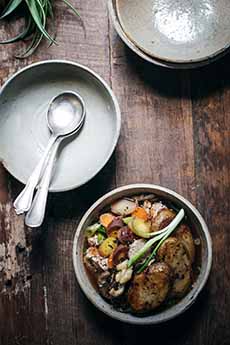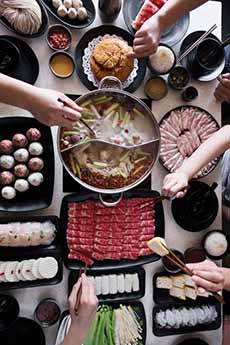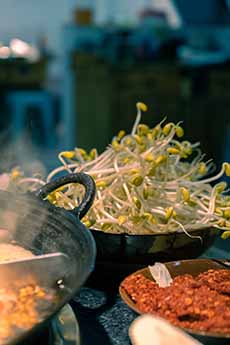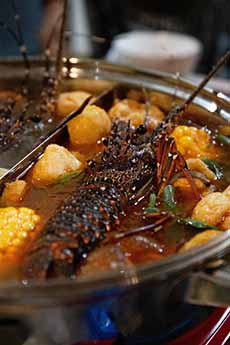Potato, Mushroom & Chicken Hot Pot Recipe
|
|
May 11th is Eat What You Want Day. While some people use this as an excuse to pile on the sugar or chips, we’re using it to shed light on a dish not enjoyed enough in the U.S.: hot pot. You may have heard of Mongolian hot pot (or hotpot), a dish that is served at restaurants devoted to the dish. We had hoped to head out to Flushing, Queens, to our favorite hot pot restaurant, Xiang Hotpot. But we couldn’t get away, so we made our own Asian-inspired chicken hot pot recipe, Potato Mushroom Chicken Hot Pot. The recipe is below. The recipe below lets you enjoy a family dinner in a slightly different way. It’s an adaptation of comfort food that brings to the table a pot of simmering chicken broth stocked with chicken. Each diner dips vegetables into the broth, to cook them. It’s fun and festive. In our childhood, perusing the menu at our family’s favorite Chinese restaurant, our eyes always stopped at the fetching-sounding Mongolian Hot Pot. We wanted one, but Mom didn’t. So it remained a simmering desire in our heart until we were old enough to take ourselves to the restaurant. It was worth the wait. We were delighted and enamored. Hot pot or hotpot (the term in China is literally “fire pot”), is a cooking method from Mongolia. It’s a simmering pot of soup stock brought to the dining table, containing a variety of raw meats, seafood, vegetables, and noodles to be cooked in the hot broth; then dipped into a variety of sauces (momiji-oroshi [chili-radish], ponzu, sesame, soy, etc. (photo #7). It’s a group meal: the hot broth at the center of the table, surrounded by platters of food to be cooked. Mongolian Hot Pot is perhaps the best-known dish of Mongolia, an autonomous region of northeast China*. Like fondue, it’s a group meal; except that the bubbling pot is filled with broth instead of cheese; and there’s no bread or other eady-to-eat foods to dip on skewers, but instead, a large selection of raw foods. Little Sheep Mongolian Hot Pot, a chain with thousands of locations in Asia and a toehold several locations in North America, has a variety of broths and some 100 dipping items, ranging from shellfish to lamb meatballs to thin-sliced beef and kidney; and almost every vegetable you can name. Check out some examples here. And dumplings—don’t forget the dumplings. ribeye and pork kidney to winter melon, lotus root, egg dumplings, and oyster mushrooms. It’s a franchise, so if you have visions of Hot Pot whenever you want it, check it out. Both Mongolian Hot Pot and Japanese Shabu Shabu fall into the category of cooking raw ingredients in a hot broth. The main difference is that shabu-shabu is milder, served with only kombu dashi (seaweed) broth instead of the variously spiced broths of Mongolian Hot Pot. Yes, Mongolian Hot Pot’s broths are bold, as well as fragrant. At Little Sheep Mongolian Hot Pot, the principal broth has a blend of 36 aromatic ingredients, including black cardamom pods, whole garlic cloves, goji berries and ginseng [source]. Hot Pot restaurants offer a variety of broths. Some restaurants use a “split pot” divided into two sections (photos #2, #3, and #5). One can hold a spicy broth, and the other a milder broth. As the concept spread beyond Mongolia, the dish took on flavors and ingredients that vary by region—from curry to tom yum broths. Szechuan Hot Pot, for example, offers a chicken broth highly spiced with chiles and peppercorns. The recipe that follows is an Americanized hot pot. It’s a simple technique, made for the average home. No special pots or other equipment are required. This recipe for Potato, Mushroom & Chicken Hot Pot (photo #1) is not Mongolian, but was created “in the spirit” of Asian hot pots by Stacey Doyle of Little Figgy Food, for the Idaho Potato Commission. The idea is to enjoy a group dinner of simmering the vegetables in the broth, along with the already-cooked chicken. The cooking process is similar to the fondue style of cooking, both of which enable enjoyable mealtime with each other while each person cooks his/her own food. The recipe combines fresh and wholesome ingredients like mushrooms, carrots, spring onions, Idaho® potatoes, chicken breasts, and stock—with flavorful mix-ins like soy sauce, poultry herbs, and crushed red pepper flakes. This slurp-worthy soup is best served the same day and is a filling comfort-food dinner. Customize it as you like. For example: If you don’t have a jar of poultry herb seasoning, you can blend your own with these ingredients: NOTE: In addition to poultry, you can use poultry seasoning—a blend of popular herbs—on beef, lamb, pork, and vegetables; in soups, and in sauces. It’s most flavorful when added to food during the last few minutes of cooking. You can also season appetizers, breads, and salads. 1. DRY CHAR† the sliced mushrooms in a large nonstick saucepan or casserole pan over medium heat, until they start to turn golden, about 5 minutes. Remove from pan and set aside. 2. ADD ¼ cup of the white wine to deglaze the pan. Add the olive oil and heat over medium-high heat. 3. ADD the carrots and potatoes and cook for about 10 minutes. Turn halfway through and cook until the potatoes start to turn golden and the carrots are just starting to soften. Optionally, if you prefer, you can set aside the potatoes to add at the end and enjoy like steak cut fries; or leave them to continue cooking. 4. ADD the scallions, chopped cooked chicken, broth, soy sauce, the remaining white wine, the poultry herb seasoning, and the cooked mushrooms. Turn the heat to medium-low and continue to cook for 15-20 minutes, stirring occasionally. Taste and adjust flavor if needed. 5. GARNISH with scallions if desired, and serve with optional hot sauce or crushed red pepper flakes. |
|
|
________________ *You may have heard of both Inner Mongolia and Outer Mongolia. Since 1912, Mongolia has been an independent country, sometimes referred to as Outer Mongolia. It is sandwiched between China and Russia. Inner Mongolia is an autonomous region of China, equivalent to a province. It is to the east of the sovereign nation of Mongolia. Both countries speak a variety of languages within the Mongolian language family. †To dry char, simply place the mushrooms in a pan and cook them on the stovetop, with no butter or oil. By skipping the fat, the pan will get very hot without smoking, so the mushrooms become charred (not steamed or smoked) as they cook. CHECK OUT WHAT’S HAPPENING ON OUR HOME PAGE, THENIBBLE.COM. |
||










